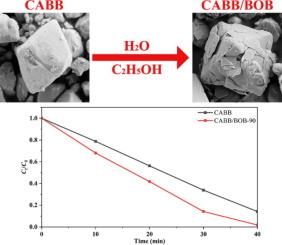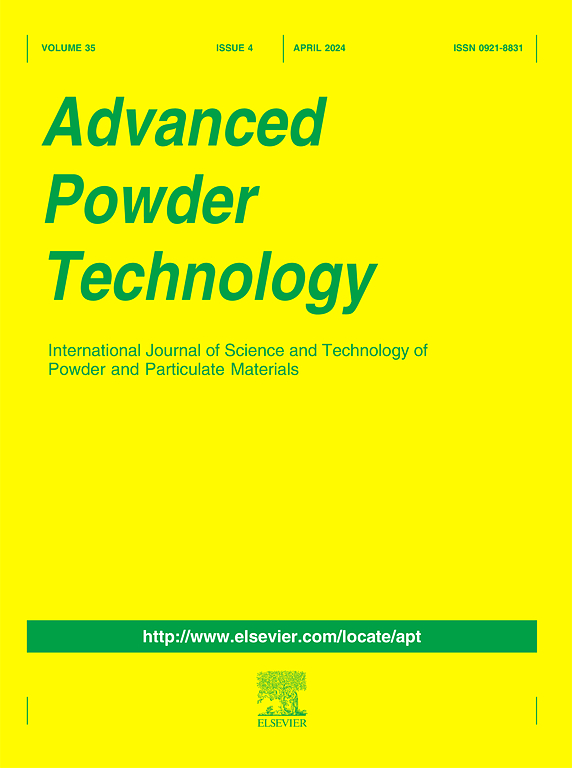水诱导形成具有增强可见光光催化活性的 Cs2AgBiBr6/BiOBr 异质结构
IF 4.2
2区 工程技术
Q2 ENGINEERING, CHEMICAL
引用次数: 0
摘要
Cs2AgBiBr6 (CABB) 的深能量缺陷和高激子结合能限制了光生电荷的分离和转移。建立异质结构是解决这一障碍的一条大有可为的途径。本文在乙醇的帮助下,将CABB浸入水溶液中,在CABB八面体表面外延生长出BiOBr(BOB)纳米片,从而形成了有趣的CABB/BOB异质结。CABB/BOB 异质结构明显提高了水稳定性,即使在乙醇和水的混合物中浸泡 100 小时,其结构和形态仍能保持不变。与 CABB 和 BOB 这两种原始成分相比,CABB/BOB 光催化剂在降解罗丹明 B 方面的光催化活性明显增强。具体来说,先进的 CABB/BOB-90 光催化剂在 40 分钟内的降解效率达到 98%,分别比最初的 CABB 和 BOB 光催化剂高出约 1.3 倍和 4.1 倍。光催化活性的提高归功于紧密结合的异质结界面的形成,它促进了电荷载流子的有效分离。本文章由计算机程序翻译,如有差异,请以英文原文为准。

Water-induced formation of Cs2AgBiBr6/BiOBr heterostructure with enhanced visible-light photocatalytic activity
The separation and transfer of photogenerated charges are limited by the deep energy defects and high exciton binding energy of Cs2AgBiBr6 (CABB). The creation of heterostructure is a great promising path to solve this obstacle. In this paper, BiOBr (BOB) nanosheets epitaxially grew on the surface of CABB octahedrons through immersing CABB into in water-solution with the assistance of ethanol, thereby creating an interesting CABB/BOB heterojunction. The CABB/BOB heterostructure markedly enhances water stability, preserving its structure and morphology even after being submerged in a mixture of ethanol and water for 100 h. The CABB/BOB photocatalyst exhibited significantly enhanced photocatalytic activity towards the degradation of Rhodamine B in comparison to its individual pristine components, namely CABB and BOB. Specifically, the advanced CABB/BOB−90 photocatalyst attains a degradation efficiency of 98 % within 40 min, significantly surpassing the initial CABB and BOB photocatalysts by approximately 1.3 and 4.1 times, respectively. The heightened photocatalytic activity is attributable to the formation of a tightly integrated heterojunction interface, which promotes the efficient separation of charge carriers.
求助全文
通过发布文献求助,成功后即可免费获取论文全文。
去求助
来源期刊

Advanced Powder Technology
工程技术-工程:化工
CiteScore
9.50
自引率
7.70%
发文量
424
审稿时长
55 days
期刊介绍:
The aim of Advanced Powder Technology is to meet the demand for an international journal that integrates all aspects of science and technology research on powder and particulate materials. The journal fulfills this purpose by publishing original research papers, rapid communications, reviews, and translated articles by prominent researchers worldwide.
The editorial work of Advanced Powder Technology, which was founded as the International Journal of the Society of Powder Technology, Japan, is now shared by distinguished board members, who operate in a unique framework designed to respond to the increasing global demand for articles on not only powder and particles, but also on various materials produced from them.
Advanced Powder Technology covers various areas, but a discussion of powder and particles is required in articles. Topics include: Production of powder and particulate materials in gases and liquids(nanoparticles, fine ceramics, pharmaceuticals, novel functional materials, etc.); Aerosol and colloidal processing; Powder and particle characterization; Dynamics and phenomena; Calculation and simulation (CFD, DEM, Monte Carlo method, population balance, etc.); Measurement and control of powder processes; Particle modification; Comminution; Powder handling and operations (storage, transport, granulation, separation, fluidization, etc.)
 求助内容:
求助内容: 应助结果提醒方式:
应助结果提醒方式:


